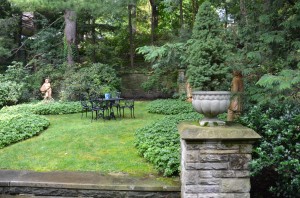How many times have you been told: “you can’t grow lawn grass in shady areas”. Most lawn grasses perform best in full sunlight. Red or chewings fescues (Festuca rubra) perform under as little as 2-3 hours of direct or dappled sunlight.
Shade fescues are relatively easy to maintain. Mowing height should be 2 inches high in spring and fall and 2 ½ inches in summer. They do not require much fertilizer. Red fescues tolerate winter cold temperatures, but are less drought and heat tolerant than tall fescues. They also resent heavy foot traffic.
Fertilize shade fescue lawns at least twice annually – March or April and again in September or October. When starting a new seeding, use 3-4 lbs. seed/1000 sq. ft. rate.
Preparing new ground: rototill to a depth of 4-6 inches. Have a soil test performed at least 4-6 weeks prior to seeding to accurately determine how much lime (or gypsum) and fertilizer to apply. If the soil has not been tested in 3 or more years, apply a complete lawn fertilizer (contains N, P, and K) according to recommended rate on the package. Evenly rake fertilizer and organic amendments into soil and eliminate soil ruts.
Evenly disburse (sow) grass seed according to recommended package seeding rates. Lightly rake the seed into the soil ⅛ inch deep. Keep the area watered daily (if no rainfall) until seeds have germinated (usually in 10-14 days) and the seedlings have grown sufficiently to establish a lawn.
Extra step prior to seeding: if the site is excessively weedy, mow the area and apply a non-selective herbicide such as glyphosate (Roundup™).
Covering Bare Spots: Mow lawn closely, rake up cut grass, leaves, stones, sticks and other debris. Sow seed in bare areas by hand, fertilize and add soil amendments as needed. Seeding rate is 1-2 lbs per 1000 square feet.


 Posted in
Posted in 
